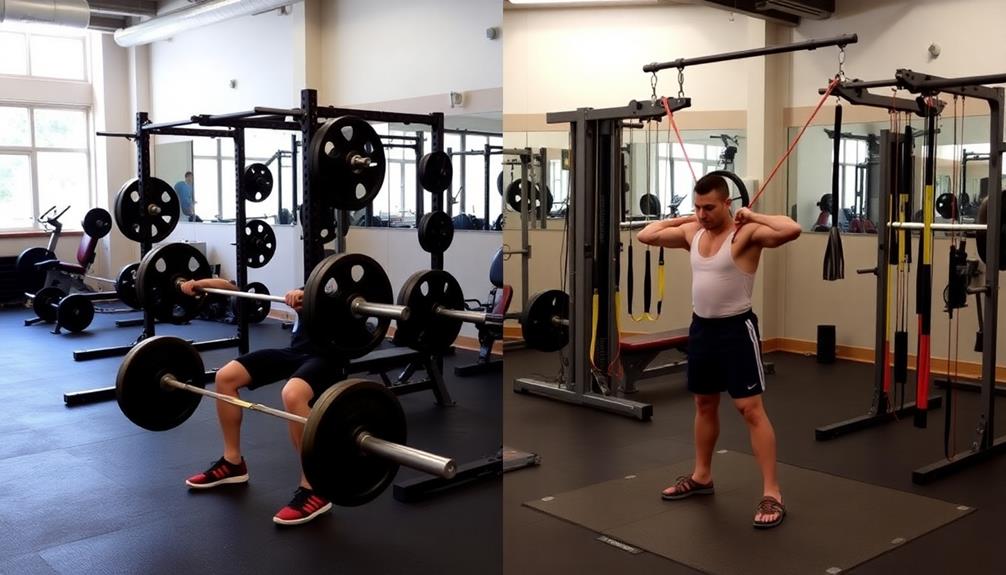Strength and resistance training differ in five key areas. First, strength training focuses on building raw muscle power, while resistance training aims for muscle endurance and toning. Second, strength training typically uses heavy weights with low reps, whereas resistance training employs lighter weights with higher reps. Third, strength training primarily targets type II muscle fibers, while resistance training works both type I and II fibers. Fourth, strength training emphasizes compound movements like squats, while resistance training includes more varied exercises. Finally, strength training often leads to greater muscle size, while resistance training may improve overall muscle quality. Exploring these differences can help you choose the right approach for your fitness goals.
Core Insight
- Strength training focuses on heavy weights and low reps, while resistance training often uses lighter weights and higher reps.
- Strength training primarily targets type II muscle fibers, whereas resistance training works both type I and II fibers.
- Equipment for strength training includes barbells and power racks, while resistance training utilizes bands, cables, and bodyweight exercises.
- Strength training aims to increase maximum lift capacity, while resistance training emphasizes muscle endurance and toning.
- Progression in strength training involves increasing weight lifted, while resistance training progresses through rep increases and rest adjustments.
Primary Focus and Goals

The main goals of strength training and resistance training are quite different. Strength training focuses on making your muscles stronger so you can lift more weight. You'll do exercises that work big muscle groups, using heavy weights and low reps. The aim is to increase your maximum lift in a single attempt and get stronger overall. Muscle building supplements can help with this by providing ingredients that support muscle growth and recovery.
Resistance training is more about improving muscle endurance and getting a toned look. You'll use lighter weights and do more reps, focusing on smooth, controlled movements. The goal is to make your muscles bigger, more defined, and able to work for longer periods without getting tired. Both types of training can make your muscles grow, but strength training is all about pure power, while resistance training sculpts your muscles and builds stamina.
Equipment and Tools Used

The gear you use for strength and resistance training can be similar, but there are a few important differences. For strength training, barbells, dumbbells, power racks, and weight plates are the usual tools. Resistance training often uses resistance bands, cable machines, bodyweight exercises, and kettlebells.
This table shows typical equipment for each training style:
| Strength Training | Resistance Training |
|---|---|
| Barbells | Resistance Bands |
| Dumbbells | Cable Machines |
| Power Racks | Bodyweight |
| Weight Plates | Kettlebells |
You can use some of this equipment for both types of training, but how you use it will be different. Strength training uses heavy weights and low reps. Resistance training has more options and often uses higher reps. Pick the right tools based on your goals and the training style you want to use.
Intensity and Load Progression

Strength training and resistance training progress differently in intensity and load. In strength training, you gradually increase the weight you lift, using heavier loads and fewer reps. This challenges your muscles to get stronger, usually with 1-5 reps per set. Supplements like MuscleTech HMB can help build lean muscle during tough strength sessions.
Resistance training focuses on progressive overload in various ways. You might do more reps, change the speed of your movements, or adjust rest times between sets. Increasing weights is important, but not always the main goal. You'll usually do 8-15 reps per set for muscle endurance and growth, plus strength gains.
Both methods need consistent effort and good form to work, but they progress in different ways.
Exercise Selection and Variation

Strength training and resistance training use different exercises over time. Strength training uses compound movements like squats and deadlifts that work many muscles at once. The goal is to lift more weight in these key exercises.
Resistance training uses more types of exercises. It includes both compound and isolation movements to target specific muscles. You can use machines, cables, bodyweight exercises, and resistance tubes. Resistance tubes come in different levels, so you can progress as you get stronger. You can also change the angles or variations of an exercise to keep your muscles growing.
Both types of training are good, but they have different purposes. Strength training is about getting better at important lifts. Resistance training gives you more options to work specific muscles.
Impact on Muscle Fibers

Strength training and resistance training both work your muscles, but they have some differences. Strength training focuses more on type II muscle fibers, which are used for powerful movements. These fibers get bigger, making your muscles stronger and larger overall.
Resistance training works both type I and type II fibers. It helps your muscles last longer during exercise and can make them a bit bigger too. Type I fibers are important for activities that require endurance, and they work better after resistance training. If you want to gain muscle while eating healthy, adding almond butter to your diet can give you important nutrients and good fats to help with your training.
While both kinds of training can make your muscles grow, strength training usually leads to more muscle size. Resistance training, on the other hand, may be better for improving muscle endurance and overall quality. Knowing these differences can help you choose the right workouts for your fitness goals.
Frequently Asked Questions
How Does Age Affect the Choice Between Strength and Resistance Training?
As you age, your goals and physical capabilities change. You'll want to focus more on resistance training for muscle maintenance and bone health. However, you can still incorporate strength training, adjusting intensity to suit your needs.
Can Strength and Resistance Training Be Combined in a Single Workout?
Yes, you can combine strength and resistance training in one workout. You'll often find they overlap naturally. By incorporating both, you're able to target different aspects of fitness, maximizing your time and achieving well-rounded results.
Which Type of Training Is Better for Weight Loss?
You'll find both strength and resistance training effective for weight loss. They boost your metabolism and build muscle, which burns more calories. However, combining them with cardio and a balanced diet will yield the best results for shedding pounds.
Are There Gender-Specific Considerations for Strength Versus Resistance Training?
You'll find that both men and women can benefit from strength and resistance training. However, women may focus more on toning and endurance, while men often prioritize muscle mass. Adjust your approach based on your personal goals.
How Do Recovery Times Differ Between Strength and Resistance Training Programs?
You'll typically need longer recovery times for strength training due to its higher intensity. Resistance training often allows for shorter rest periods between sessions, as it's generally less taxing on your central nervous system.

